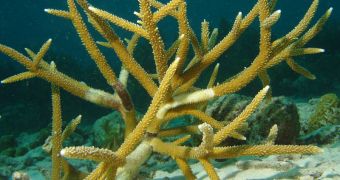A team of investigators at the Massachusetts Institute of Technology (MIT) announces the discovery of a mechanism that enables bacteria living in the world's oceans to attack and infect vulnerable corals.
Coral reefs around the world are endangered by factors such as climate change, global warming and ocean acidification. The latter, in particular, is especially worrying, since it promotes coral bleaching.
This phenomenon occurs when the algae that live in harmony with polyps inside corals are ejected from the coral exoskeleton due to increased concentrations of carbonic acid in the water, higher overall water temperatures, and a host of other factors.
Previous studies have demonstrated that bleaching makes corals more vulnerable to infections by bacteria such as the coral pathogen Vibrio corallilyticus. However, the exact mechanisms through which the microorganisms figure out which corals to attack have thus far remained elusive.
Researchers at MIT went about solving this problem by stressing a few Pocillopora damicornis corals. This lead to an increase in the production of a sulfurous compound called dimethylsulfoniopropionate (DMSP) by as much as 500 percent.
A variety of advanced imaging methods were used to keep track of V. corallilyticus' motions and behaviors in the water, when such high concentrations of the mucus were available. The team found that the bacteria tended to swim up to 50 percent faster in the presence of DMSP.
“This is the first time we’ve been able to sneak a peek at a coral pathogen’s behavior in real time, as it responds to the chemical cues leaking into the seawater from its host,” says Melissa Garren, a postdoctoral researcher with the Department of Civil and Environmental Engineering (CEE) at MIT.
She was also the first author on a new paper detailing the findings, which was published in the December 12 issue of the International Society for Microbial Ecology Journal. Lead researcher on the paper was CEE professor Roman Stocker.
“We discovered that these tiny cells have an amazing array of tricks up their sleeves for finding a host, and that they can preferentially navigate toward hosts that are stressed,” Garren explains.
Safeguarding coral reefs is a top priority for conservationists and climate scientists, due to the fact that these formations represent hot spots for extreme biodiversity in the oceans. They provide refuge and sustenance for a large number of species, both large and small, and losing them would have disastrous consequences on the marine environment.
“These experiments have helped us get one step closer to understanding the mechanisms for coral disease, because we have been able to directly visualize the microscopic pathogens of the corals as they swim with great vigor towards the coral surface,” Stocker concludes.

 14 DAY TRIAL //
14 DAY TRIAL //